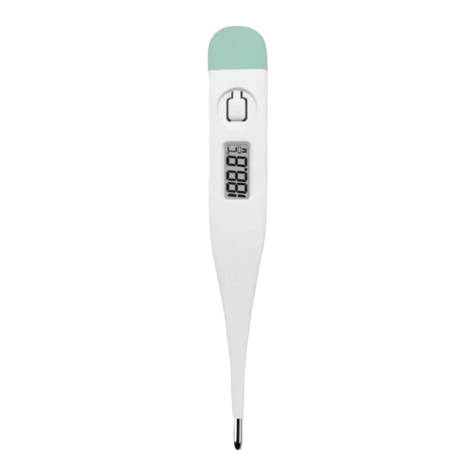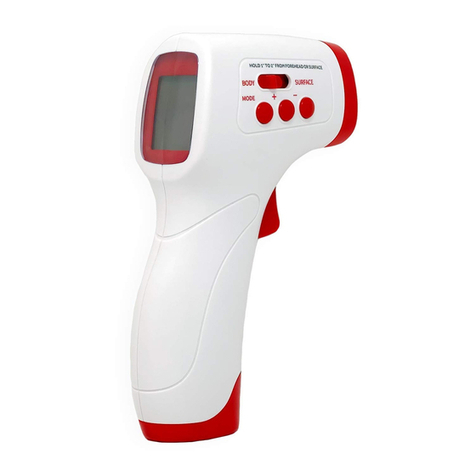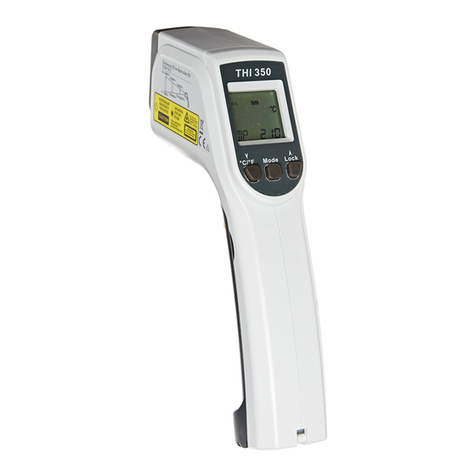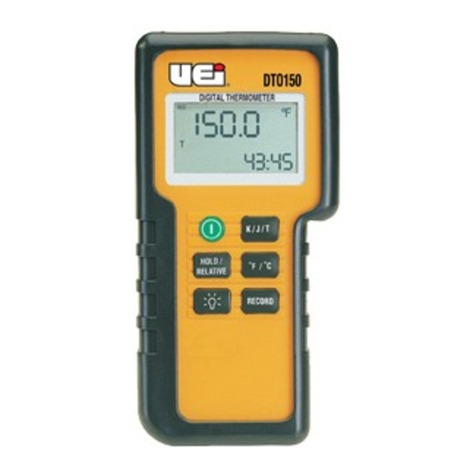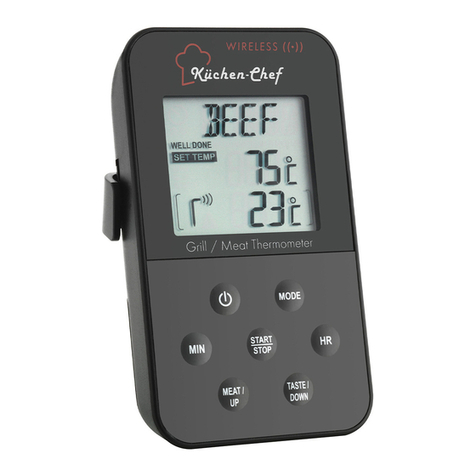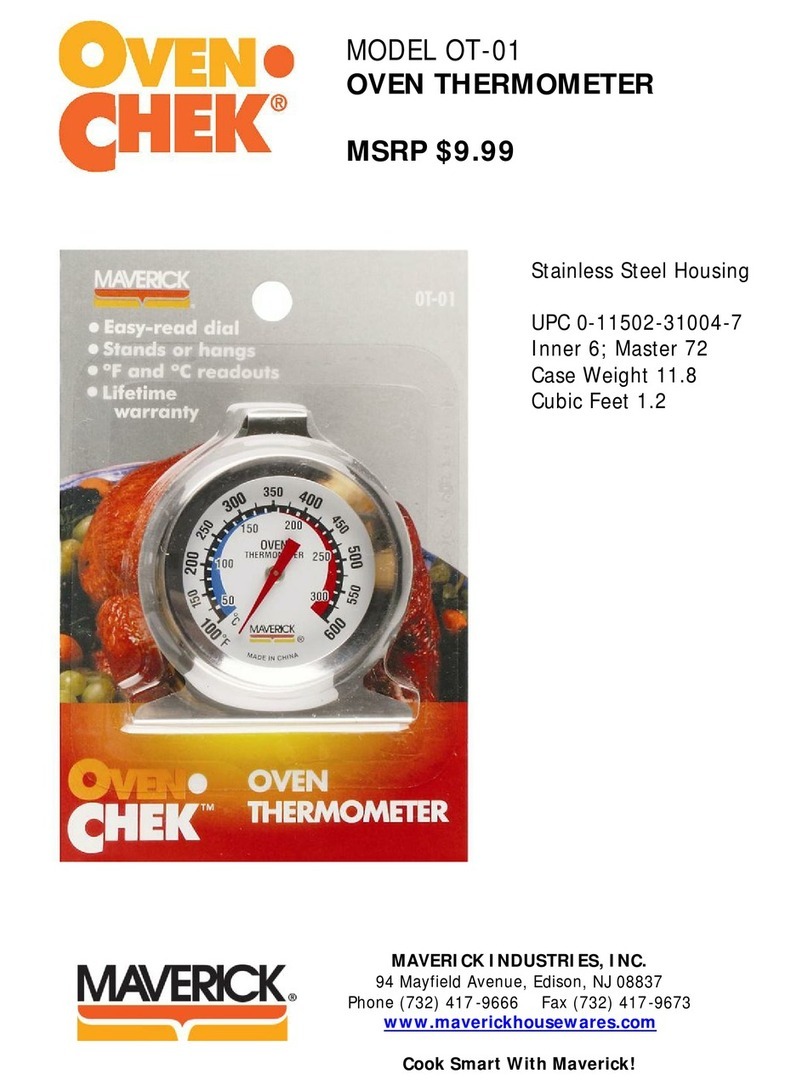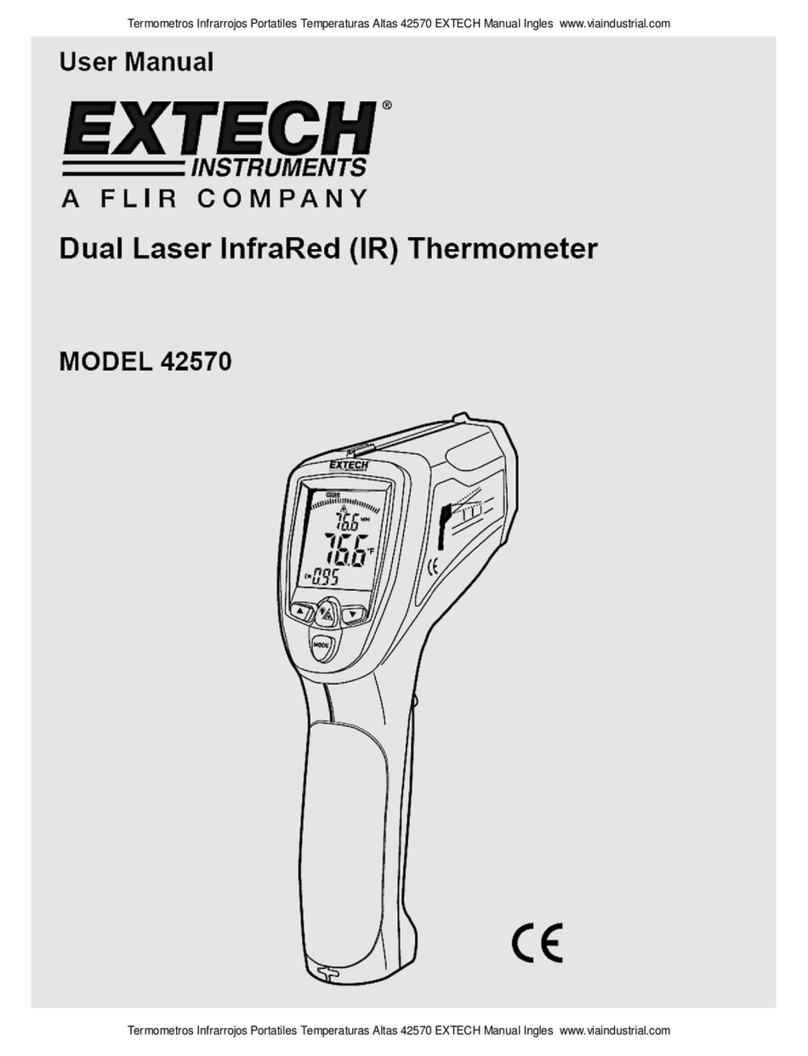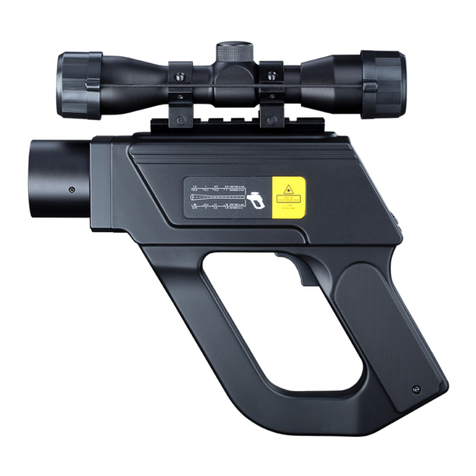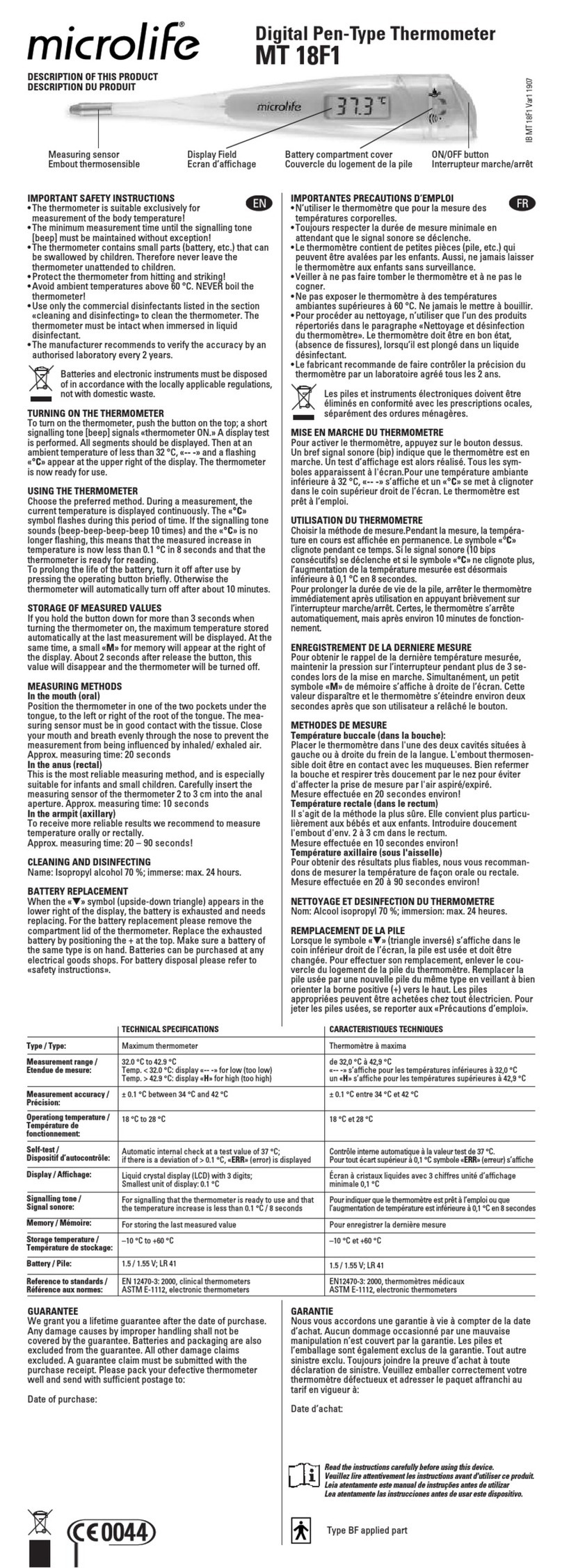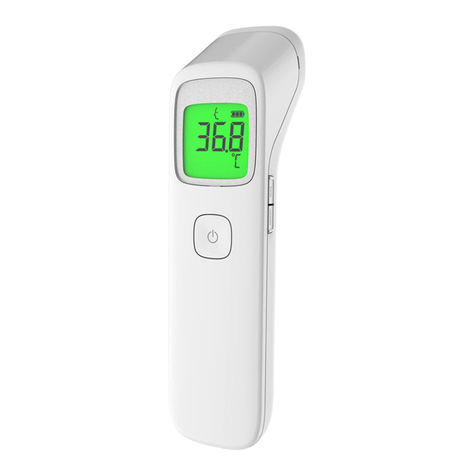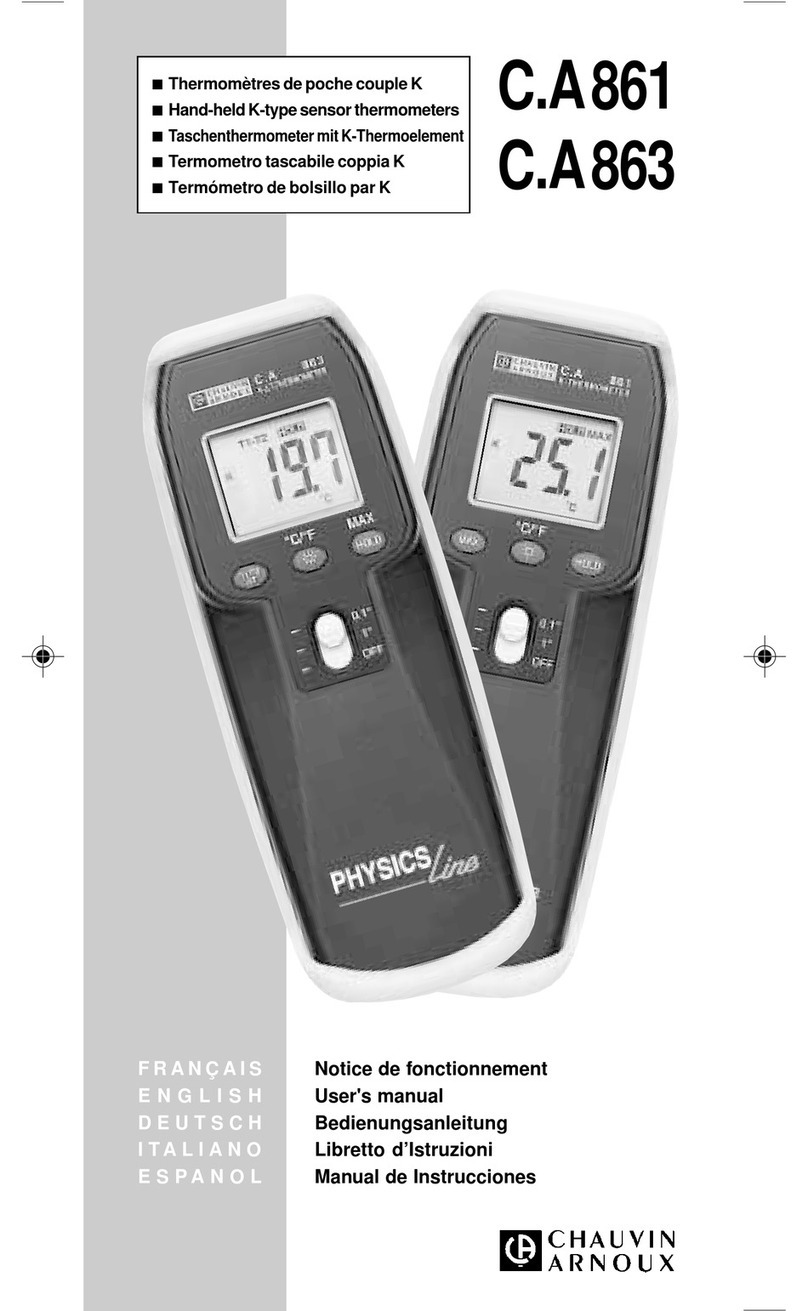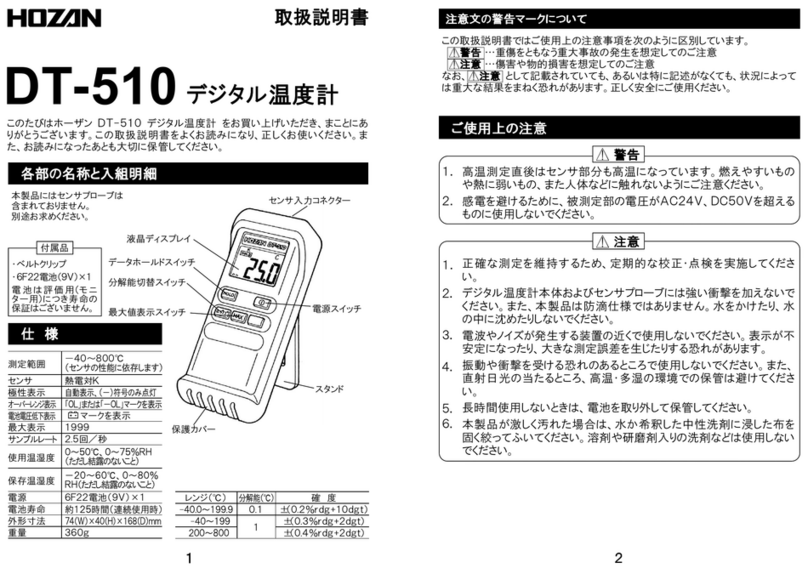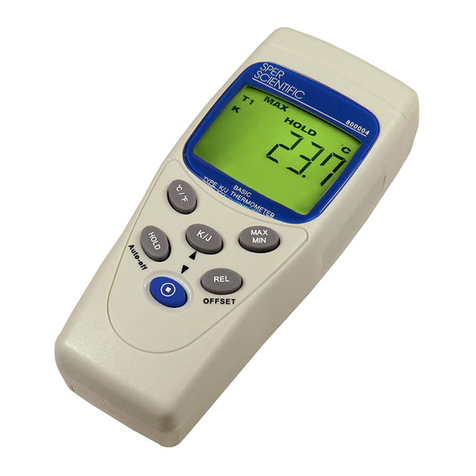GHM Delta OHM HD2101.1 User manual

Operating manual
Hygrometers / thermometers
HD2101.1 – HD2101.2
www.deltaohm.com
Companies / Brands of GHM
English
Keep for future reference.

HD2101 - 2 - V2.3
CONTENTS
INTRODUCTION..................................................................................................................................................... 3
KEYBOARD AND MENU DESCRIPTION ............................................................................................................ 8
THE PROBES..........................................................................................................................................................14
MEASUREMENT OF RELATIVE HUMIDITY..................................................................................................................14
Calibration of the combined humidity/temperature probe ...................................................................................14
Humidity and Comfort indices...........................................................................................................................16
DIRECT INPUT INTO Pt100, Pt1000 AND Ni1000 TEMPERATURE PROBES ...................................................................18
How to measure ................................................................................................................................................18
Instructions to connect the TP47 connector for 4 wire Pt100, Pt1000 and Ni1000 probes....................................18
Direct connection of 4 wire Pt100 sensors .........................................................................................................20
WARNINGS AND OPERATING INSTRUCTIONS ..............................................................................................21
INSTRUMENT SIGNALS AND FAULTS..............................................................................................................22
LOW BATTERY WARNING AND BATTERY REPLACEMENT.......................................................................24
INSTRUMENT STORAGE.....................................................................................................................................25
SERIAL INTERFACE AND USB ...........................................................................................................................26
STORING AND TRANSFERRING DATA TO A PERSONAL COMPUTER......................................................28
THE LOGGING FUNCTION -ONLY FOR HD2101.2......................................................................................................28
CLEARING THE MEMORY -ONLY FOR HD2101.2 ......................................................................................................28
THE PRINT FUNCTION ...........................................................................................................................................29
CONNECTION TO A PC........................................................................................................................................30
CONNECTION TO THE RS232C SERIAL PORT OF THE INSTRUMENT .............................................................................30
CONNECTION TO THE USB 2.0 PORT OF THE INSTRUMENT -ONLY FOR HD2101.2......................................................30
NOTES ABOUT WORKING AND OPERATING SAFETY .................................................................................31
INSTRUMENT TECHNICAL CHARACTERISTICS..........................................................................................32
TECHNICAL DATA OF PROBES AND MODULES IN LINE WITH THE INSTRUMENT ............................................................34
TEMPERATURE PROBES Pt100 SENSOR USING SICRAM MODULE.................................................................................34
RELATIVE HUMIDITY AND TEMPERATURE PROBES USING SICRAM MODULE................................................................35
PROBES Pt100 4WIRES AND Pt1000 2WIRES............................................................................................................35
ORDER CODES ......................................................................................................................................................36

HD2101 - 3 - V2.3
INTRODUCTION
The HD2101.1 and HD2101.2 are portable instruments with a large LCD display. They measure
relative humidity and temperature using a Pt100 sensor or thermocouple humidity/temperature
combined probe. Temperature only is measured by immersion, penetration or air contact probes.
The sensor can be a Pt100, Pt1000 or Ni1000.
When the combined humidity/temperature probe is connected, the instrument calculates and
displays the absolute humidity, the dew point, the partial vapour pressure, and the comfort indices.
The probes are fitted with automatic detection module, with the factory calibration settings already
being memorized inside.
The HD2101.2 instrument is a datalogger. It memorizes up to 38,000 samples which can be
transferred from the instrument connected to a PC via the RS232C serial port or USB 2.0 port. The
storing interval, printing, and baud rate can be configured using the menu.
The HD2101.1 and HD2101.2 models are fitted with an RS232C serial port and can transfer the
acquired measurements in real time to a PC or to a portable printer.
The Max, Min and Avg function calculate the maximum, minimum or average values.
Other functions include: the relative measurement REL, the HOLD function, and the automatic
turning off that can also be disabled.
The instruments have IP66 protection degree.
This manual describes the HD2101.1 and HD2101.2 models: if not otherwise specified, the
description is intended to be applicable to both models.

HD2101 - 4 - V2.3
Hygro-Thermometer
HD2101.1

HD2101 - 5 - V2.3
HD2101.1
1. Input for probes, 8-pole DIN45326 connector.
2. External auxiliary power supply connector input.
3. Battery symbol: displays the battery charge level.
4. Functions indicators.
5. Secondary display line.
6. HOLD/key: freezes the measurement during normal operation; in the menu, increases the
current value.
7. FUNC/ENTER key: during normal operation displays the maximum (MAX), the minimum
(MIN) and the average (AVG) of current measurements; in the menu, confirms the current
selection.
8. REL/key: enables the relative measurement (displays the difference between the current
value and the logged value when the key is pressed); in the menu, decreases the current value.
9. SERIAL key: starts and ends data transfer to the serial communication port.
10. MENU key: allows access to and exit from the menu.
11. °C/°F-ESC key: changes the unit of measurement for temperature from degrees Celsius to
Fahrenheit; in the menu, cancels the operation in progress without making changes.
12. UNIT/USER CAL key: during normal operation selects the unit of measurement for the main
variable; when pressed together with the FUNC key, starts the calibration procedure for the
probe connected to the instrument.
13. ON-OFF/AUTO-OFF key: turns the instrument on and off; when pressed together with the
HOLD key, disables the automatic turn off.
14. MAX, MIN and AVG symbols.
15. Line for main dispay
16. Line for symbols and comments.
17. 8-pole MiniDin connector for RS232C. For the connection to PC (with cable HD2110CSNM or
C206) or printer (with cable HD2110CSNM).

HD2101 - 6 - V2.3
Hygro-Thermometer
HD2101.2

HD2101 - 7 - V2.3
HD2101.2
1. Input for probes, 8-pole DIN45326 connector.
2. External auxiliary power supply connector input.
3. Battery symbol: displays the battery charge level.
4. Main display line.
5. Secondary display line.
6. HOLD/key: freezes the measurement during normal operation; in the menu, increases the
current value.
7. FUNC/ENTER key: during normal operation displays the maximum (MAX), the minimum
(MIN) and the average (AVG) of current measurements; in the menu confirms the current
selection.
8. REL/key: enables the relative measurement (displays the difference between the current
value and the logged value when the key is pressed); in the menu, decreases the current value.
9. SERIAL/ERASE LOG key: starts and ends data transfer to the serial communication port. In
the menu, clears the data contained in the instrument's memory.
10. LOG/DUMP LOG key: during normal operation, starts and ends the saving of the data in the
internal memory; in the menu, starts the data transfer from the instrument's memory to the PC.
11. Mini-USB type B connector for USB 2.0. For the connection to PC (with cable CP23).
12. MENU key: allows access to and exit from the menu.
13. °C/°F-ESC key: changes the unit of measurement for temperature from degrees Celsius to
Fahrenheit; in the menu, cancels the operation in progress without making changes.
14. UNIT/USER CAL key: during normal operation selects the unit of measurement for the main
variable; when pressed together with the FUNC key, starts the calibration procedure for the
probe connected to the instrument.
15. ON-OFF/AUTO-OFF key: turns the instrument on and off; when pressed together with the
HOLD key, disables the automatic turn off.
16. MAX, MIN and AVG symbols.
17. Main display line
18. Line for symbols and comments.
19. 8-pole MiniDin connector for RS232C. For the connection to PC (with cable HD2110CSNM or
C206) or printer (with cable HD2110CSNM).

HD2101 - 8 - V2.3
KEYBOARD AND MENU DESCRIPTION
Foreword
The instrument keyboard is composed of single-function keys, like the MENU key, and double-
function keys such as the ON-OFF/Auto-OFF key.
In the double-keys, the function in the upper part is the "main function", while the one in the bottom
part is the "secondary function". When the instrument is in standard measurement mode, the main
function is active. In the menu or in conjunction with the FUNC key, the secondary function is
enabled.
The pressing of a key is accompanied by a short confirmation beep: a longer beep sounds if the
wrong key is pressed.
Each key specific function is described in detail below.
ON-OFF/Auto-OFF key
The instrument is turned on and off using the ON/OFF key. The turning on enables all display
segments for a few seconds, starts an auto-test including the detection of the probe connected to the
input and sets the instrument ready for normal measurement.
MIN
cm
min s
2
3
m
µ
m
k
>>>
During turning on, should no probes be connected, the message "NO_PRBE_ SER_NUM" is
displayed in the line for symbols for a few seconds, and in the main line a series of dashes
appears while the ERR message replaces the temperature.
When the probe is inserted into a functioning instrument, the "NEW_PROB_DET" (New
probe detected) message appears: as the probe's data are captured upon turning the
instrument on, it is necessary to turn the instrument off and on again.
Replace the probes when the instrument is off.
+
Automatic turning off
The instrument has an AutoPowerOff function that automatically turns the instrument off after about
8 minutes if no key is pressed during the intervening time. The AutoPowerOff function can be
disabled by holding the HOLD key pressed down when turning the instrument on: the battery
symbol will blink to remind the user that the instrument can only be turned off by pressing the
<ON/OFF> key.

HD2101 - 9 - V2.3
The automatic turning off function is disabled when external power is used. On the other
hand, it cannot be disabled when the batteries are discharged.
FUNC/ENTER key
During normal measurement this enables the display and logging of the maximum (MAX),
minimum (MIN) and average (AVG) value of the measurements captured by the probe connected to
the instrument, updating them with the acquisition of new samples. The acquisition frequency is
once a second.
In the menu, the ENTER key confirms the current parameter and then goes to the next one.
The MAX, MIN and AVG measurements remain in the memory until the instrument is on, even
after exiting the calculation function. To reset the previous values and restart with a new
measurement session, press FUNC until the message "FUNC CLR" appears, then use the arrows to
select YES and confirm using ENTER.
Attention: the data captured using the Record function cannot be transferred to the PC.
HOLD/key
It increases the current parameter when used in the menu; when used in measurement mode, it freezes
the measurement in progress, and upon application of pressure on the key, the message HOLD
appears in the upper side of the display. To return to the current measurement, press the key again.
Upon turning on the instrument, the AutoPowerOff function can be disabled by holding the HOLD
key down (please see the ON-OFF key description).
UNIT/UserCAL key
In measurement mode, it allows selection of the unit of measurement of the main input quantity
(shown in the central line of the display). By repeatedly pressing the function key, the different
units of measurement are displayed in sequence:
1. %RH % of relative humidity
2. g/kg Grams of vapor in a kilogram of dry air
3. g/m3Grams of vapor in a cubic meter of dry air
4. hPa Partial vapor pressure (hPa)
5. J/g Enthalpy
6. Td Dew point (°C or °F)
7. Tw Wet bulb temperature (°C or °F)
8. DI Discomfort Index
9. NET Net Index
This setting changes the information displayed and the immediate print of data (SERIAL key). The
data recorded using the LOG function (HD2101.2) and sent to the printer or PC through the
serial port using the SERIAL function (HD2101.1 and HD2101.2), keep the chosen unit of
measurement and display it.

HD2101 - 10 - V2.3
+
%RH probe calibration
Simultaneous pressure on the UNIT and FUNC keys starts the calibration procedure of the probe
connected to the instrument. Please see the paragraph dedicated to calibration on page 14.
°C/°F - ESC key
Changes the unit of measurement for the temperature from degrees Celsius to Fahrenheit for both
the main and secondary variable.
When used in the menu, it clears or cancels the active function.
REL/key
In measurement mode, it displays the difference between the current value and that measured on
pressing the key for both measurements - main and secondary. The REL message appears on the
display; press the key again to return to the current measurement.
When used in the menu, it decreases the current variable value.
MENU Key
The first menu item is accessed by initially pressing on the MENU key; press ENTER to go to the
following items. To modify the item displayed, use the arrow keys (and ). The current value is
confirmed by pressing the ENTER key and the display moves on to the next parameter, by pressing
the ESC key the setting is cleared.
To exit the menu, press the MENU key at any time.
The menu items are listed in this order:
1) Management of logged data (only HD2101.2): the message ">>>_LOG_DUMP_or_E-
RAS" (Transfer data or erase) is scrolled in the comment line. The center figure reports the
number of free memory pages (FREE). All memory data are permanently erased by pressing
SERIAL/EraseLOG. By pressing LOG/DumpLOG, the data transfer of the logged data on
the serial port is started: the "BAUD-RATE" must have previously been set to the maximum
value (please see the menu items described below and the paragraph "STORING AND
TRANSFERRING DATA TO A PERSONAL COMPUTER" on page 28).

HD2101 - 11 - V2.3
2) Probe type: the message ">>>_PRBE_TYPE" is scrolled in the comment line. The main
line in the center of the display shows the type of probe connected to the instrument. The
following probes can be connected to the input:
•humidity/temperature combined probes with Pt100 sensor complete with SICRAM
module
•humidity/temperature combined probes with thermocouple K sensor complete with
SICRAM module
•temperature probes Pt100 complete with SICRAM module
•direct 4 wire Pt100 probes complete with TP47 module
•2 wire Pt1000 probes complete with TP47 module
•2 wire Ni1000 probes complete with TP47 module
Upon turning on the instrument automatically detects the probes fitted with SICRAM
module, the Delta Ohm Pt1000 and Ni1000: the Probe Type menu item is configured by the
instrument and cannot be modified by the user.
The temperature probes direct 4 wire Pt100, the Pt1000 and the Ni1000 are manufactured by
Delta OHM. When turned on they display the message "NO_PRBE_SER_NUM". In this
case the probe type must be entered manually. Select Probe type using the MENU key and
then select the type of probe used with the arrow keys; confirm using ENTER.
3) Print and log interval: sets the interval in seconds between two loggings or data transfers
to the serial port. The interval can be set at 0, 1s, 5s, 10s, 15s, 30s, 60s (1min), 120s (2min),
300s (5min), 600s (10min), 900s (15min), 1200s (20min), 1800s (30min) and 3600s (1hour).
If the value 0 is set, SERIAL works on command: the sending of data to the serial port
is performed each time the key is pressed. Recording (LOG) is performed with one
second intervals even if the interval is set to 0. With an interval from 1 to 3600s, continuous
data transfer is started when the SERIAL key is pressed. To end the recording (LOG) and
continuous data transfer operations (SERIAL with an interval greater than 0), press the
same key again.
4) Sleep_Mode_LOG (Automatic turning off during logging) (only HD2101.2): this
function controls the instrument's automatic turning off during logging, occurring between
the capture of a sample and the next one. When the interval is lower than 60 seconds, the
instrument will always remain on. With intervals greater than or equal to 60 seconds, it is
possible to turn off the instrument between loggings: it will turn on at the moment of
sampling and will turn off immediately afterwards, thus increasing the battery life. Using the
arrows select YES and confirm using ENTER in order to enable the automatic turning off,
select NO and confirm to disable it and keep the instrument on continuously.
Note: even if Sleep_Mode_LOG=YES is selected, the instrument does not turn off for less
than one minute intervals.
5) YEAR: to set the current year. Use the arrows to modify this parameter and confirm using
ENTER.
6) MNTH (month): to set the current month. Use the arrows to modify this parameter and
confirm using ENTER.
7) DAY: to set the current day. Use the arrows to modify this parameter and confirm using
ENTER.
8) HOUR: to set the current hour. Use the arrows to modify this parameter and confirm using
ENTER.

HD2101 - 12 - V2.3
9) MIN (minutes): to set the current minutes. In order to correctly synchronize the minute, it is
possible to reset the seconds by pressing the UNIT key. Use the arrows to set the current
minute plus one, and as soon as that minute is reached press UNIT: this synchronizes the
time to the second. Press ENTER to go onto the next item.
10) BAUD_RATE: indicates the frequency used for the serial communication with the PC.
Values from 1200 to 38400 baud. Use the arrows to modify this parameter and confirm
using ENTER. The communication between instrument and PC (or serial port printer)
only works if the instrument and PC baud rates are the same. If the USB connection is
used this parameter value is automatically set (please see the details on page 28).
LOG/DumpLOG key - only HD2101.2
In measurement mode, this function starts and stops the logging of a data block to be saved in the
instrument's internal memory. The data logging frequency is set in the "Print and log interval"
menu parameter. The data logged between a start and subsequent stop represent a block.
When the logging function is on, the LOG indication is displayed, the battery symbol blinks and a
beep is issued each time a logging occurs; the battery symbol does not appear when using an
external power supply.
To end the logging, press LOG.
The HD2101.2 can turn off during logging between one capture and the next: the function is
controlled by the Sleep_Mode_LOG parameter. When the logging interval is less than one minute,
the logging instrument remains on; with an interval of at least one minute, it turns off between one
capture and the next if the parameter Sleep_Mode_LOG=YES.
>>>
Dump LOG - only HD2101.2
When the LOG key is pressed after the MENU key, the transfer of the logged data on the serial port
is started.
Please see the paragraph dedicated to data transfer on page 28.
SERIAL key - only HD2101.1
SERIAL/EraseLOG key - only HD2101.2
In measurement mode, this function starts and stops the data transfer to the RS232C serial output.
According to the settings entered in the Print and log interval menu item, a single sample can be
printed if Print and log interval=0 or a continuous indefinite printing of the measured data can be
set up if Print and log interval=1…3600.

HD2101 - 13 - V2.3
The printing operation is accompanied by the display of the RS232 symbol and the blinking of the
battery symbol; when using an external power supply the battery symbol does not appear.
Press SERIAL to end the continuous printing.
Before starting the printing with SERIAL, set the baud rate. To do so, select the Baud Rate menu
item and select the maximum value equal to 38400 baud by using the arrows. Confirm with
ENTER.
The DeltaLog9 software for PC will automatically set the baud rate value during connection. If you
are using a different program than DeltaLog9, be sure the baud rate is the same for both the
instrument and the PC: the communication will only work in this way.
>>>
Erase memory - only HD2101.2
When pressed after the MENU key, the SERIAL key permanently erases all the data contained in
the instrument's memory.

HD2101 - 14 - V2.3
THE PROBES
The instrument works by using combined humidity/temperature probes (temperature with a Pt100
sensor or thermocouple) and with temperature only probes with 4 wire Pt100, or 2 wire Pt1000 or
Ni1000. The combined humidity/temperature probes are fitted with SICRAM module that acts as an
interface between the sensor on the probe and the instrument. There is a microprocessor circuit
with a permanent memory inside the module that enables the datalogger to recognize the type of
probe connected and to read its calibration information.
The Delta Ohm Pt1000 and Ni1000 probes are automatically detected while the direct 4 wire Pt100
temperature probe is not automatically detected by the instrument and must be set up in the Probe
type menu item (please see the description of the menu on page 11).
The probe is detected during turn on, and this cannot be performed when the instrument is
already on, therefore if a probe is connected and the instrument is on, it is necessary to turn it
off and on.
MEASUREMENT OF RELATIVE HUMIDITY
The humidity probes are humidity/temperature combined probes: the humidity sensor is a
capacitative type sensor, while according to the model the temperature sensor is either a Pt100 or a
thermocouple K.
The instrument measures relative humidity %RH and temperature, and starting from the fixed
barometric pressure value of 1013.25mbar it calculates the following resulting quantities:
1. g/kg Grams of vapor in a kilogram of dry air
2. g/m3Grams of vapor in a cubic meter of dry air
3. hPa Partial vapor pressure (hPa)
4. J/g Enthalpy
5. Td Dew point (°C or °F)
6. Tw Wet bulb temperature (°C or °F)
7. DI Discomfort Index
8. NET Net Index
For a detailed description of the meaning of Discomfort index and Net index, please see the para-
graph Humidity and Comfort indices on page 16.
A measurement is performed by placing the probe in the area of whose parameters you wish to
measure. Keep the probe far from elements that might interfere with measurement such as: heat or
sources of cooling, walls, air-streams, etc. Avoid temperature drops that might cause condensation.
A reading taken when no heat drop occurs is practically immediate. In contrast, in conditions
involving heat drops, it is necessary to wait until the probes and their housing have reached a
thermal equilibrium in order to prevent heat irradiation or absorption on the relative humidity
sensor, which would cause a faulty measurement. Since temperature affects relative humidity; move
the probe like a fan in order to speed the response time in the presence of heat drops.
Calibration of the combined humidity/temperature probe
To calibrate the probes correctly, a knowledge of and abiding by the physical phenomena on which
the measurement is based is fundamental: this is the reason why it is recommended to abide by what
is reported below carefully and only to perform new calibrations if technically proficient.

HD2101 - 15 - V2.3
The probes are calibrated in our laboratory at 23°C at the points of 75%RH, 33%RH and 11.4%RH.
On request, the probes can be checked at different isotherms.
The calibration of the temperature sensor by the user is not required: the sensor is calibrated
in the factory and the Callendar Van Dusen parameters are recorded in the SICRAM module.
In order to calibrate the instrument correctly, it is very important for the probe and the saturated
solutions to maintain the same temperature and that this is as stable as possible during the entire
calibration operation.
Calibration sequence:
1. Unscrew the sensor protection on the top of the probe.
2. In its place screw the bored cap with the threaded ring very well at the base (there are two
types of thread: M24x1,5 and M12x1, so use the appropriate one).
3. Open the cap for the 75%RH saturated solution.
4. Should there be any drops of solution inside the measuring chamber, dry them with some
blotting paper.
5. Insert the probe in the container, making sure the cap at the base is screwed well. The
measuring chamber must be closed perfectly, otherwise it will not get saturated: it is
essential that no air passes through it.
6. Wait at least 30 minutes.
7. Press contemporarily FUNC/Enter and UNIT/UserCAL: the message "PROB_CAL_EXIT
_ OR_75_OR_33_OR_11" is scrolled in the upper part of the display. To proceed with the
calibration, using the arrows select 75%, and confirm using UNIT/UserCAL. [To exit
without calibrating the probe, press UNIT/UserCAL when the message "nonE" (None)
appears].
8. The relative humidity read by the probe is shown: if necessary, correct the value of the
saturated solution against the 75.0% proposed by the instrument using the arrows and .
The temperature is measured by the Pt100 or TC sensor. Press ENTER to confirm the
calibration point. The instrument returns to the calibration main page and displays "nonE".
To proceed with another point, select it using the arrows and confirm it using
UNIT/UserCAL [to return to measurement mode, press UNIT/UserCAL when the message
"nonE" appears].
9. Remove the probe from the 75%RH container and close it immediately using its cap.
Calibrating the points at 33%RH and 11%RH
Repeat the points from 3) to 9) using the saturated salts at 33%RH and 11%RH
When completed, unscrew the ring with the cap, and screw the protection grid back on the sensors.
The calibration is now complete.
Important notes:
1) Do not let hands touch the RH sensor
2) The sensor base is in alumina so it could easily break
3) During the entire calibration cycle keep the temperature as constant as possible; plastic
materials are poor thermal conductors, therefore some time is needed for them to reach a
thermal equilibrium
4) In case no satisfactory results are obtained, check that:
•the sensor is not faulty, corroded or dirty
•the measuring chamber is perfectly closed during calibration
•the saturated solutions are not exhausted A saturated solution at 11%RH or 33%RH is
exhausted when there is no more salt inside between the two walls but only a thick liquid: in

HD2101 - 16 - V2.3
this case the chamber cannot reach its saturation anymore. For the saturated solutions at
75%RH, check that the salt is not dry (crystallized) for in order to reach the saturation, it
needs to be wet
5) Storage of the saturated solutions: the saturated solutions must be stored in a dark environment
at a constant temperature of about 20°C with the container well closed inside a dry room
Relative humidity of saturated salts at different temperatures
Temp Lithium Potassium Magnesium Potassium Magnesium Sodium Potassium Potassium Potassium
°C Chloride Acetate Chloride Carbonate Nitrate Chloride Chloride Nitrate Sulphate
0 11.23 ± 0.54 33.66 ± 0.33 43.13 ± 0.66 60.35 ± 0.55 75.51 ± 0.34 88.61 ± 0.53 96.33 ± 2.9 98.77 ± 1.10
5 11.26 ± 0.47 33.60 ± 0.28 43.13 ± 0.50 58.86 ± 0.43 75.65 ± 0.27 87.67 ± 0.45 96.27 ± 2.1 98.48 ± 0.91
10 11.29 ± 0.41 23.28 ± 0.53 33.47 ± 0.24 43.14 ± 0.39 57.36 ± 0.33 75.67 ± 0.22 86.77 ± 0.39 95.96 ± 1.4 98.18 ± 0.76
15 11.30 ± 0.35 23.40 ± 0.32 33.30 ± 0.21 43.15 ± 0.33 55.87 ± 0.27 75.61 ± 0.18 85.92 ± 0.33 95.41 ± 0.96 97.89 ± 0.63
20 11.31 ± 0.31 23.11 ± 0.25 33.07 ± 0.18 43.16 ± 0.33 54.38 ± 0.23 75.47 ± 0.14 85.11 ± 0.29 94.62 ± 0.66 97.59 ± 0.53
25 11.30 ± 0.27 22.51 ± 0.32 32.78 ± 0.16 43.16 ± 0.39 52.89 ± 0.22 75.29 ± 0.12 84.34 ± 0.26 93.58 ± 0.55 97.30 ± 0.45
30 11.28 ± 0.24 21.61 ± 0.53 32.44 ± 0.14 43.17 ± 0.50 51.40 + 0.24 75.09 ± 0.11 83.62 ± 0.25 92.31 ± 0.60 97.00 ± 0.40
35 11.25 ± 0.22 32.05 ± 0.13 49.91 ± 0.29 74.87 ± 0.12 82.95 ± 0.25 90.79 ± 0.83 96.71 ± 0.38
40 11.21 ± 0.21 31.60 ± 0.13 48.42 ± 0.37 74.68 ± 0.13 82.32 ± 0.25 89.03 ± 1.2 96.41 ± 0.38
45 11.16 ± 0.21 31.10 ± 0.13 46.93 ± 0.47 74.52 ± 0.16 81.74 ± 0.28 87.03 ± 1.8 96.12 ± 0.40
50 11.10 ± 0.22 30.54 ± 0.14 45.44 ± 0.60 74.43 ± 0.19 81.20 ± 0.31 84.78 ± 2.5 95.82 ± 0.45
55 11.03 ± 0.23 29.93 ± 0.16 74.41 ± 0.24 80.70 ± 0.35
60 10.95 ± 0.26 29.26 ± 0.18 74.50 ± 0.30 80.25 ± 0.41
65 10.86 ± 0.29 28.54 ± 0.21 74.71 ± 0.37 79.85 ± 0.48
70 10.75 ± 0.33 27.77 ± 0.25 75.06 ± 0.45 79.49 ± 0.57
75 10.64 ± 0.38 26.94 ± 0.29 75.58 ± 0.55 79.17 ± 0.66
80 10.51 ± 0.44 26.05 ± 0.34 76.29 ± 0.65 78.90 ± 0.77
85 10.38 ± 0.51 25.11 ± 0.39 78.68 ± 0.89
90 10.23 ± 0.59 24.12 ± 0.46 78.50 ± 1.00
95 10.07 ± 0.67 23.07 ± 0.52
100 9.90 ± 0.77 21.97 ± 0.60
Humidity and Comfort indices
Environmental conditions influence physical well being: particular values of temperature, humidity
and wind speed give rise to specific conditions which are annoying or even intolerable. While it is
easy to calculate the effects of each variable on man when considered separately, it is more
complex to provide an indication of the combined effect of all three variables.
Various evaluation systems have been introduced to formulate the climatic quality indices
(Comfort Indices).
The indices calculated by the instrument are the Discomfort Index (DI) and the Net Index (NET).
These two indices will be displayed if the instrument is connected to a humidity/temperature
combined probe.
The Net Index also considers the wind speed but its contribution is ignored as its influence is
negligible.

HD2101 - 17 - V2.3
According to the value supplied by the DI index (Discomfort Index), the climatic conditions range
from comfortable to somewhat annoying, and then intolerable:
Comfortable Not very annoying Annoying Very annoying Intolerable
68 70 75 80 86
There are four possible causes of local discomfort:
•high vertical difference of temperature
•too hot or cold floor
•high asymmetry of radiation temperature
•air streams
The NET INDEX gives the so-called "apparent temperature": in the presence of optimum climatic
conditions, the Net Index approaches the temperature T expressed in degrees Celsius. As the
climate departs further and further from the optimum conditions, the influence of humidity becomes
more and more obvious. The Net Index provides an apparent temperature that reflects the typical
sensations of man and departs considerably from the value of temperature alone:
•in a hot climate, the NET INDEX increases with the increase of temperature and/or
humidity
•in a cold climate, the NET INDEX decreases with the temperature and with the increase of
humidity.

HD2101 - 18 - V2.3
DIRECT INPUT INTO Pt100, Pt1000 and Ni1000 TEMPERATURE PROBES
The instrument accepts the input of Platinum temperature probes with resistances of 100Ωand
1000Ω, as well as Nickel temperature probes with a 1000Ωresistance.
The Pt100 are connected to 4 wires, the Pt1000 and Ni1000 to 2 wires, with the excitation current
chosen minimizing the sensor self-heating effects.
All probes with module are calibrated in the factory, the 2 or 4 wire probes with direct input are
checked for conformity with class A tolerance according to norm IEC751 - BS1904 - DIN43760.
The probes with SICRAM module, the Delta OHM Pt1000 and Ni1000, are detected by the instru-
ment; but the model configuration is required for the other probes (please see the description of the
Probe Type menu item on page 11).
The °C or °F unit of measurement can be chosen for display, printing, and logging using the °C/°F-
ESC key.
How to measure
The temperature measurement by immersion is carried out by inserting the probe in the liquid for at
least 60mm; the sensor is housed in the end part of the probe.
In the temperature measurement by penetration the probe tip must be inserted to a depth of at least
60mm, the sensor is housed in the end part of the probe. When measuring the temperature on frozen
blocks it is convenient to use a mechanical tool to bore a cavity in which to insert the tip probe.
In order to perform a correct contact measurement, the measurement surface must be even and
smooth, and the probe must be perpendicular to the measurement plane.
So as to obtain the correct measurement, the insertion of a drop of oil or heat-conductive
paste is useful (do not use water or solvents). This method also improves the response time.
Instructions to connect the TP47 connector for 4 wire Pt100, Pt1000 and Ni1000 probes
All probes produced by Delta Ohm are provided with a connector. The HD2101.1 and HD2101.2
instruments also work with 4 wire direct Pt100, Pt1000 and Ni1000 probes manufactured by other
producers: for the instrument connection is prescribed the TP47 connector to which the probe's
wires should be welded.
The instructions to connect the Platinum or Nickel probe to the module are provided below.
The module is supplied complete with fairlead and gasket for 5mm maximum diameter cables.
Do the following to open the module and connect a probe:
Unscrew the fairlead and extract the gasket, remove the label using a cutter, unscrew the ring on the
opposite side as illustrated in the figure:

HD2101 - 19 - V2.3
Open the two module shells: the printed circuit to which the probe must be connected is housed
inside. On the left there are the 1…4 points on which the sensor wires must be welded. The
JP1…JP4 jumpers are in the center of the board. These must be closed with a tin bead for some type
of sensors:
1
2
3
4
Pt100 3 wires
Pt1000
Ni1000
Not Used
Before welding, pass the probe cable through the fairlead and gasket.
Weld the wires as shown in the table:
Sensor TP47 card connection Jumper to close
Pt100 4 wires
4JP4
3JP3
1JP1
2JP2
Pt100
4 wires
None
Pt1000 2 wires
JP4
4
JP3
3
JP1
1
JP22
Pt1000
2 wires
JP2
Ni1000
JP4
4
JP3
3
JP1
1
JP2
2
Ni1000
2 wires
JP3
Ensure the welds are clean and perfect. Once the welding operation is complete, close the two
shells, insert the gasket in the module, and screw the fairlead and the ring. At the other end of the
module, enter the ring with the O-Ring. Make sure the cable is not twisted while you are screwing
the fairlead. Now the probe is ready.

HD2101 - 20 - V2.3
Direct connection of 4 wire Pt100 sensors
4 wire Pt100 sensors can be soldered di-
rectly to the pins of the free female con-
nector without making use of the TP47
board. The 4 wires of the Pt100 sensors
have to be soldered as indicated in the
figure on the left.
In order to use this type of probe it is
necessary to set up the menu item “Probe
Type” as described at page 11.
The P100 probe is recognized upon turn-
ing on the instrument: connect the probe
when the instrument is switched off and
then turn it on.
Sensor Direct soldering to the connector
4-wire Pt100
View of the soldering side
of the free female connector
This manual suits for next models
2
Table of contents
Other GHM Thermometer manuals
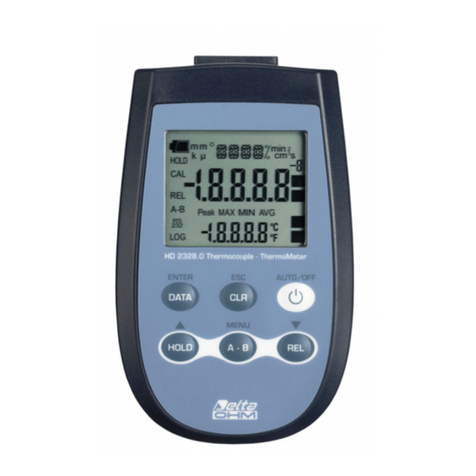
GHM
GHM Delta OHM HD2328.0 User manual
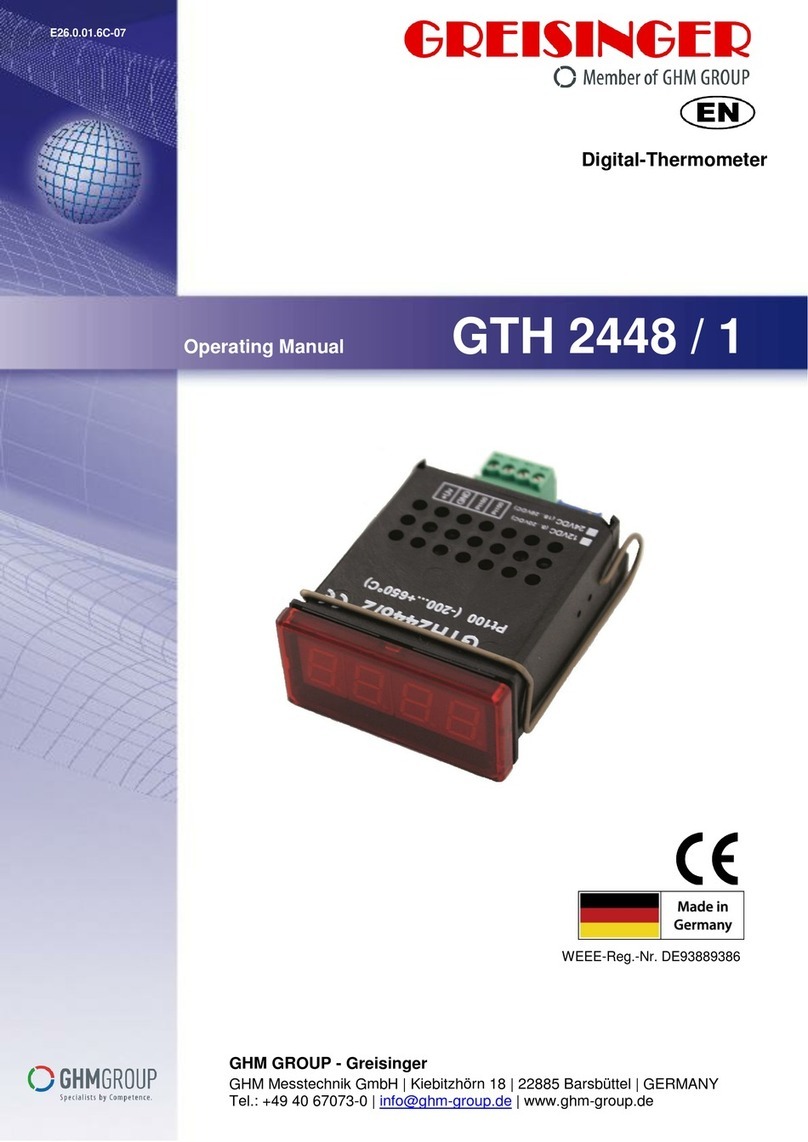
GHM
GHM GREISINGER GTH 2448 / 1 User manual
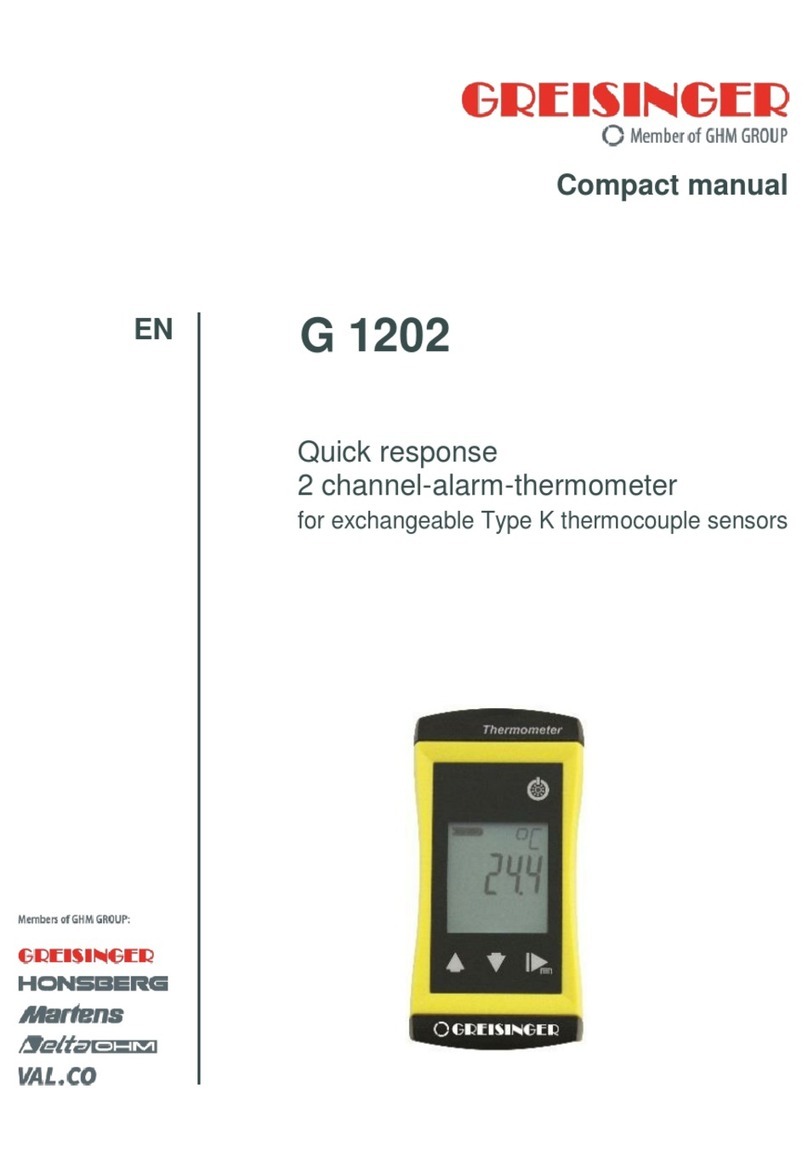
GHM
GHM GREISINGER G 1202 Installation instructions

GHM
GHM Greisinger G 1200 Installation instructions
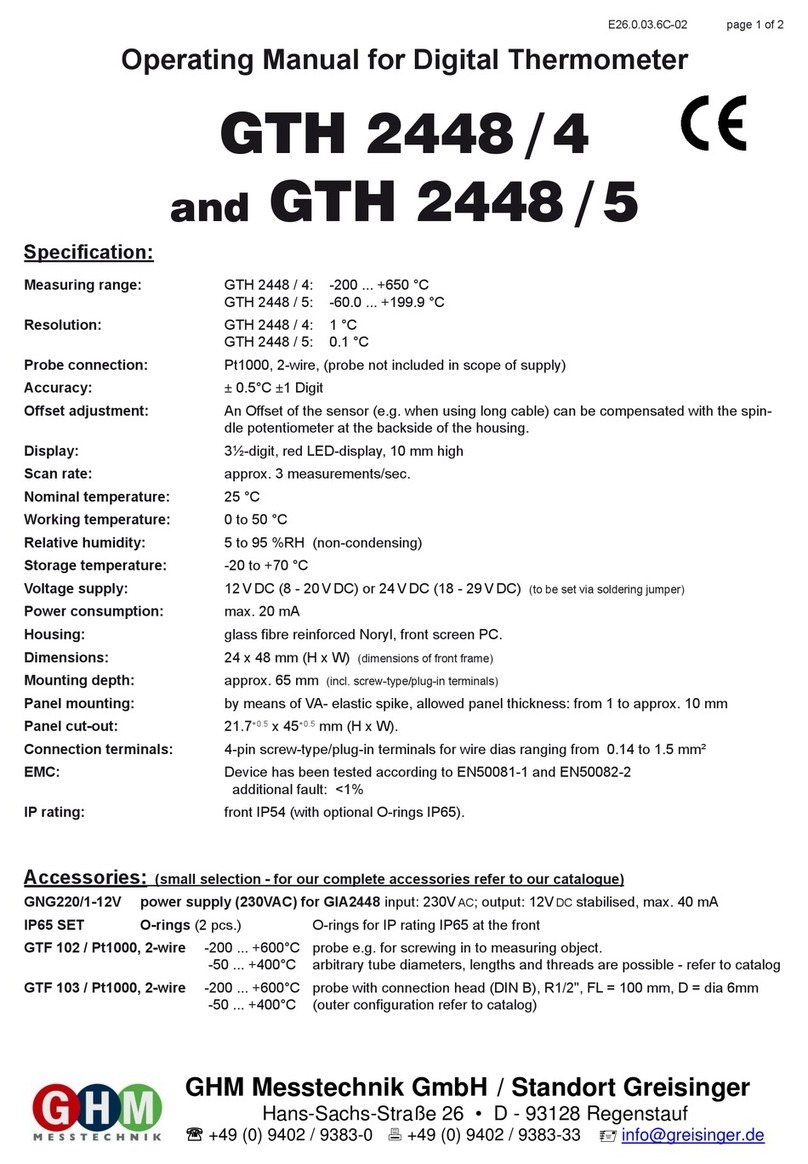
GHM
GHM GTH 2448/4 User manual
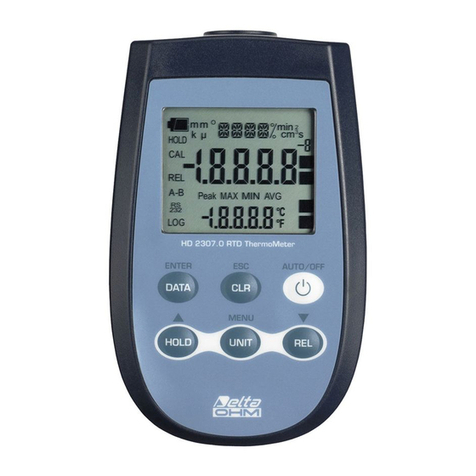
GHM
GHM Delta OHM HD2307.0 User manual
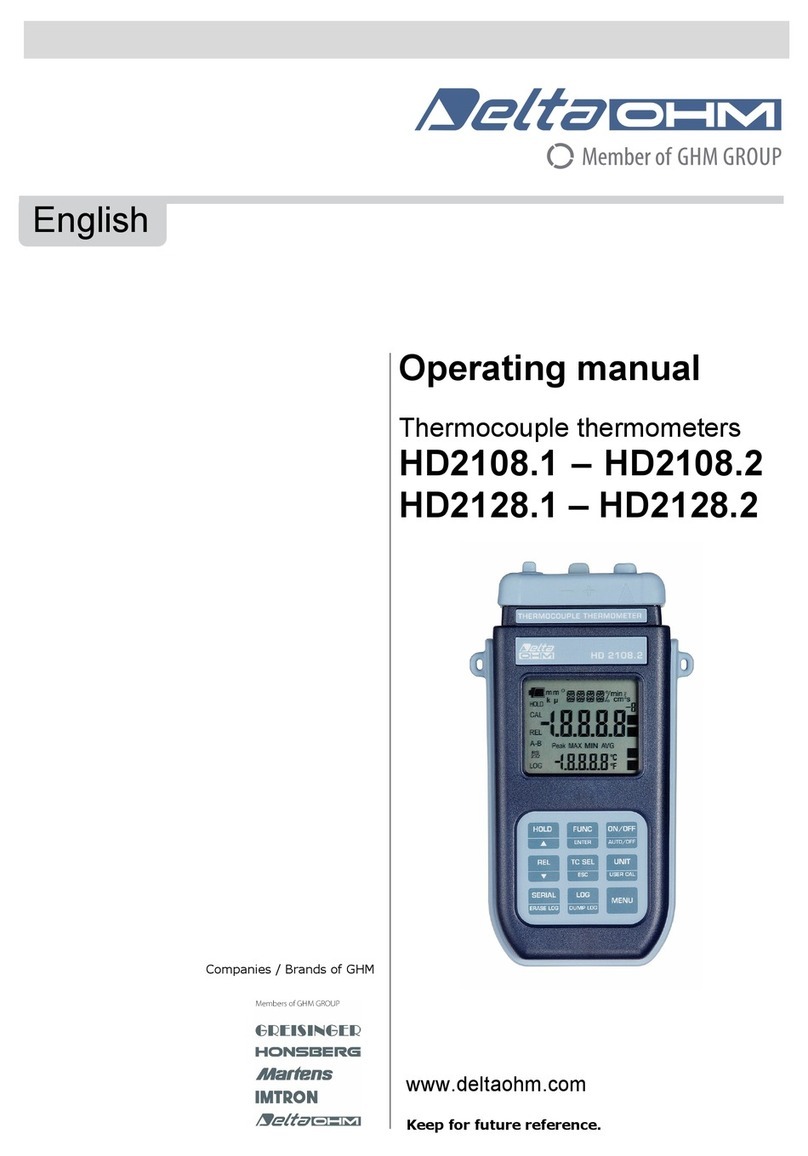
GHM
GHM Delta OHM HD2108.1 User manual

GHM
GHM GREISINGER G 1730 User manual
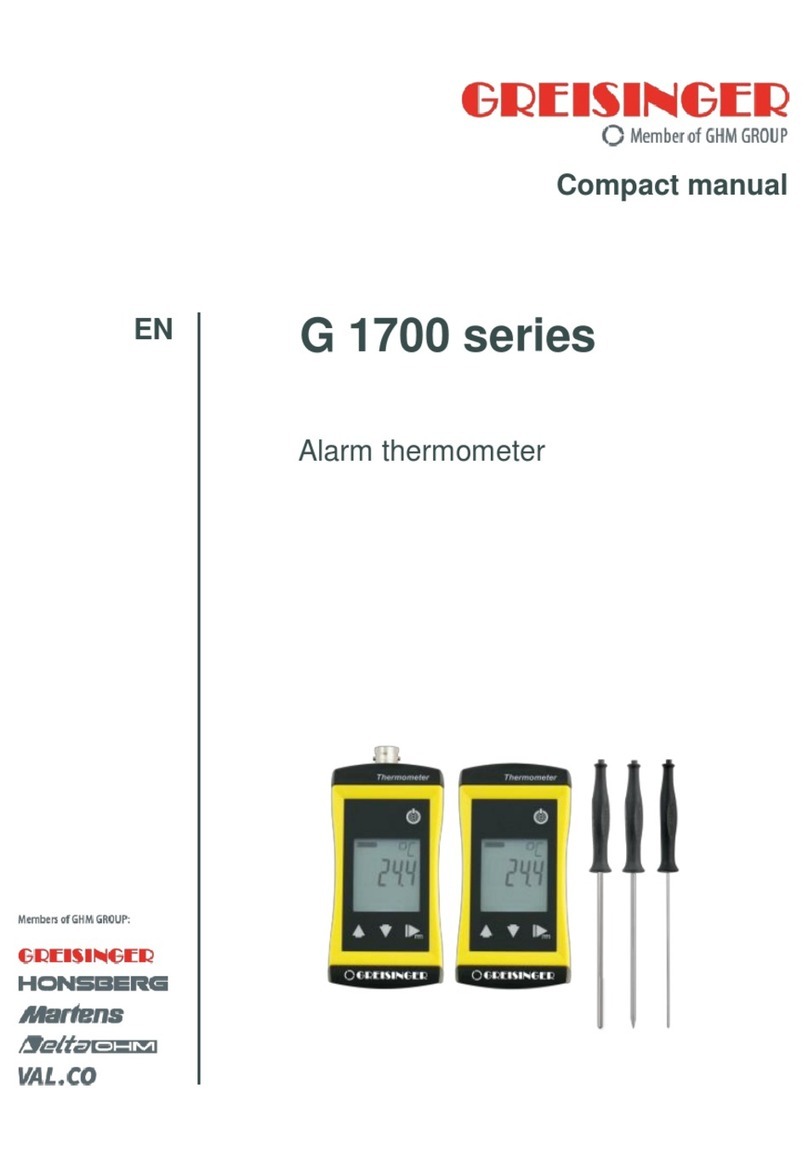
GHM
GHM GREISINGER G 1700 Series Installation instructions

GHM
GHM Greisinger GTH 2448/2 User manual




